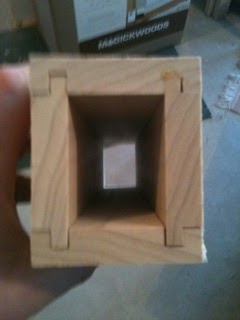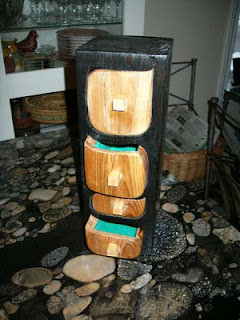On Saturday I went to use the large router table and encountered the same problem with my other Triton Router. The Triton 2 1/4 horse router is an excellent tool. I have used mine free hand and with the edge guide several times and never had a problem changing bits.
Once I put the router onto the table it was connected to:
An add on switch because I hate fumbling around under table to turn the router on and off. (especially off). This is an attempt at making my work situation safer.
 |
| off |
 |
| on |
When the router is turned on the sliding switch cover is held open by the toggle switch, which also engages a lock which does not allow the router to go beyond the bottom of the rails, where it needs to go for the bits to be changed.
When I was using the router free hand I turned in on and off with its own switch, on the table I was using the other switch and so the router thought I was on, even there was no electricity getting to it. Since the switch was ON, it was protecting me from shredding my fingers by trying to remove the bit.
In the manual it probably talks about this feature, my routers are factory refurbs and so I have everything but the manuals. (refurbs can be a great deal)
After pondering this problem, and recognizing that I was the problem not the routers as they were both doing the same thing. I called for help. I called Mark Eaton, the router guru, who I know uses this model of router all the time and explained my trouble.
Needless to say, as with all great guru's, once I clearly explained to problem. He solved it, over the phone.
WHEN IN DOUBT, CALL FOR HELP. I was on the verge of taking the router to pieces in the belief that something was in the guide rails that was blocking the router from sliding properly. Had I not called Mark, I expect that I would have have a box full of router parts and still no solution to the problem.


















